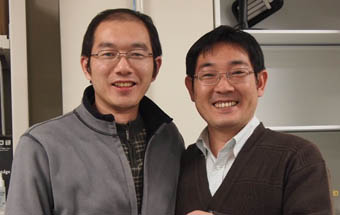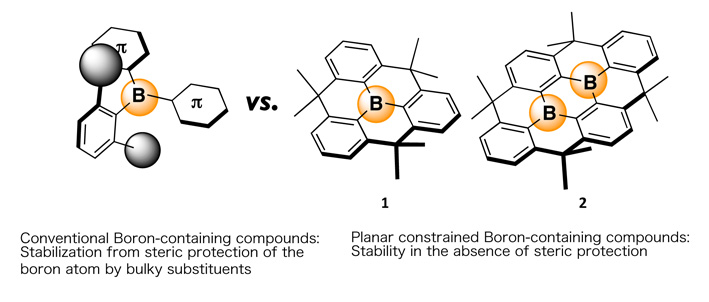Assoc Prof. Wakamiya, A., Dr. Zhou, Z., et. al. ”Development of a New Method for the Boron-doping of Two Dimensional Carbon Materials” (Published in “Journal of the American Chemical Society” 28 February 2012)
|
Development of a New Method for the Boron-doping of Two Dimensional Carbon Materials
Published in “Journal of the American Chemical Society“(Online Publication, February 28, 2012).
Assoc Prof. Wakamiya, A., Dr. Zhou, Z., et. al. |

Dr. Zhou, Z. and Assoc Prof.Wakamiya, A. (from left) |
|
| Assoc Prof. Atsushi Wakamiya, Dr. Zhiguo Zhou, Mr. Tomokatsu Kushida (Nagoya University), and Prof. Shigehiro Yamaguchi (Nagoya University) developed a new method for the boron-doping of two dimensional carbon materials, which is expected to be a promising approach towards the development of highly efficient electron transporting materials for organic electronics. | ||
|
A crucial issue in the field of organic electronics is the development of efficient electron transporting materials. The recent development of hole-transporting materials in the field of in organic photovoltaics has resulted in an improvement of the light-to-electricity conversion efficiency to 10%, even though the electron-transporting materials have been limited almost to fullerene derivatives. The development of new electron-transporting materials is therefore a key step for the development of organic photovoltaic materials with significantly increased light-to-electricity conversion efficiencies. A promising molecular design approach for novel electron-transporting materials is the incorporation of boron atoms (boron-doping) into two dimensional carbon networks (Figure1). However, in order to successfully implement the concept of “boron-doping” into the development of these materials, the crucial problem of stabilizing the resulting boron-containing organic compounds has to be overcome. |
||

Figure 1. Development of electron-transporing materials from two dimensional carbon networks by boron-doping. |
||
| The research group proposed a new concept for the kinetic stabilization of boron-containing materials based on “structural constraint”(Figure2). They have developed an effective synthetic method for the synthesis of model compounds and showed that a series of corresponding boron-containing carbon materials revealed high electron accepting abilities as well as high stability towards air and heat . These results demonstrate a new paradigm for the kinetic stabilization of boron-containing two dimensional carbon polycyclic skeletons in the absence of bulky aryl groups. T hese results should furthermore allow the development of a new class of fascinating 2D carbon materials with boron as the key element. The application of this method to boron-embedded graphene, low molecular weight polycyclic carbon materials, as well as fullerenes and carbon nanotubes would lead to the development of excellent electron-transporting materials that can realize higher light-to-electricity conversion efficiencies in organic photovoltaics. | ||

Figure 2. Introducion of a new concept for the kineic stabilizaion of boron-containing materials based on “structural |
||
| Zhou, Z.; Wakamiya, A.; Kushida, T.; Yamaguchi. S., Planarized Triarylboranes: Stabilization by Structural Constraint and Their Plane-to-Bowl Conversion, J. Am. Chem. Soc., DOI:10.1021/ja211944q (2012). | ||
 Institute for Chemical Research, Kyoto University
Institute for Chemical Research, Kyoto University International Joint Usage Research Center
International Joint Usage Research Center